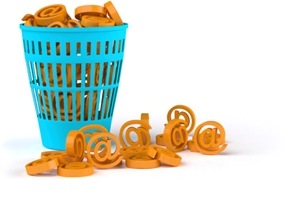Six Email Worst-Practices: How to Send Your Emails to Your Customer’s Trash
You’ve Got (Tons of) Mail
More than 205 billion emails are sent out every day; email is the glue that helps clever marketing stick. Some 72% of US adults say they prefer that companies communicate with them through email, and 91% say they’d like to receive promotional emails from the companies they do business with. And companies oblige: 73% of them agree that email is a core part of their marketing efforts, while 25% rate it as their top channel for ROI.
But many otherwise-savvy marketers are misusing email, turning to tactics that annoy and infuriate customers. Avoid these six faux pas to ensure you don’t annoy your way into the Trash folder.
1. Blast the E-Blast
“E-blast: A ridiculous non-word made up by marketing people who think the term ‘e-mail’ is inadequate to describe the explosive excitement of their mass e-mails.” —Someone named Sarah N., April 22, 2008
Gone are the days of a one-size-fits-all approach to email. Crafting one message and shooting it off to your entire list each week in hopes it’ll resonate with the multiple personalities you provide services to just won’t work anymore. Few things in life are more irritating than receiving a batch email, only to realize any prior communication with the company has meant nothing—you’re just an entry on a spreadsheet.
Customers who sense you don’t care will delete, ignore, or—worse still—unsubscribe.
And the negative connotations the term holds make us marketers wary of it, too. E-blasts cut a little too close to our collective insecurities in the marketing industry. They imply we’re launching a bunch of spam-filled emails across an unsuspecting list of contacts. I’ll skip shifting into email marketing therapist mode, but I’m confident I’m not the first marketer who’s taken serious offense at the notion that someone, at one point, thought I sounded even the slightest bit spammy.
What to do instead: We want our emails to be strategic, targeted, and personalized. We want our marketing to come off as genuine and authentic, not spammy. And, most important, our emails should be useful. Craft strong messages, with quality content, that will provide real value to your readers. Make your readers the hero of their own story. That doesn’t mean you have to craft individual messages. That’d be awesome, but time and money are finite resources. Elegantly timed trigger emails with delectable value props should be your focus. Send the right email, at the right time, for the right reason.
2. Short-Sighted Segmentation
In a micro-fragmenting ecosystem of consumer engagement, contacts have been trained to expect segmentation. Segmentation makes it easier to send content people care about—and only the content they care about. If you’re not segmenting by gender, location, age group, and the like, it’s no wonder your open rates could use improvement.
But that’s just the tip of the segmentation iceberg.
When MailChimp stats were measured across segmented campaigns, open rates were 14.13% higher than for non-segmented lists. Clicks were 63.03% higher, and abuse reports were 6.36% lower.
What to do instead: Group your audience by buying behaviors; use dynamic content; allow subscribers to let you know which topics pique their interests. Know your buyer personas, then identify your ideal consumer as individual personas. Then, break down your groups to drive a more relevant message. Relevance ramps up revenue.
3. Dear <first_name>,
“Dear <first_name>,” is not personalized content.
A slim 18% of consumers say they trust business leaders today. At its core, business is human. It’s a person talking to a person about a product or service. No business sells to another business, per se; we sell to another human who happens to work for another business. People want to do business with those with whom they can relate. They want to buy from people who have been in their shoes, and they have found the hidden key to success (your product). And they want to know that they’re important to you and that you can give them real value through resources, not just blanket offers across your customer list.
What to do instead: Netflix knows what kind of shows you’re going to watch next. Pandora plays obscure, sub-genre music you’d never have known you loved—predictively, all based on your playlist. Facebook feeds your News Feed with relevant content, custom-tailored just for you.
Personalized content helps customers relate with you, then allows them to create their own journey toward purchase. Injecting a reader’s name into the design, segmenting based on location, or creating real-time personalization by using content for specific variables such as weather, offers up the most relevant messages to your contacts and drives big results.
4. From: joe@company.com “Hey, I’m Joe. Nice to talk to you. My name’s Joe.”
So, you’re at a party and you have this conversation:
Person 1: Hey man, I’m Joe
Person 2: Hey Joe, nice to meet you, I’m Dan.
P 1: Do you work around here?
P 2: Yeah, right on the Circle, actually.
P 1: Sweet! I’m right down the block off Market. Well, I’m going to go say hi to the host.
P 2: Right on, man, catch you around!
P 1: You too. My name’s Joe.
P 2: …?
It looks and sounds just as vacuous as in your email signature:
P.S. Just in case you’re totally oblivious to how email works, here’s my email address at the bottom of my email from the email address you just received this email from.
Thanks,
Captain Redundant
What to do instead: Keep your signature tight! Stick to relevant and useful information, and cut your email address.
Click here to read the full article by Dan Hanrahan.





